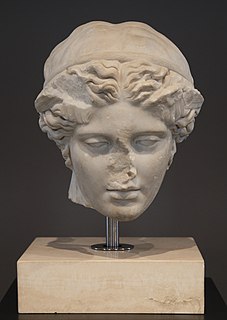
In Greek mythology, Hypnos is the personification of sleep; the Roman equivalent is known as Somnus. His name is the origin of the word hypnosis.

Imhotep was an Egyptian chancellor to the Pharaoh Djoser, probable architect of Djoser's step pyramid, and high priest of the sun god Ra at Heliopolis. Very little is known of Imhotep as a historical figure, but in the 3,000 years following his death, he was gradually glorified and deified.
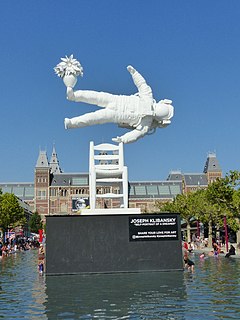
A dream is a succession of images, ideas, emotions, and sensations that usually occur involuntarily in the mind during certain stages of sleep. Humans spend about two hours dreaming per night, and each dream last around 5 to 20 minutes.

Asclepius or Hepius is a hero and god of medicine in ancient Greek religion and mythology. He is the son of Apollo and Coronis, or Arsinoe, or of Apollo alone. Asclepius represents the healing aspect of the medical arts; his daughters are Hygieia, Iaso, Aceso, Aegle and Panacea. He has several sons as well. He was associated with the Roman/Etruscan god Vediovis and the Egyptian Imhotep. He shared with Apollo the epithet Paean. The rod of Asclepius, a snake-entwined staff, remains a symbol of medicine today. Those physicians and attendants who served this god were known as the Therapeutae of Asclepius.
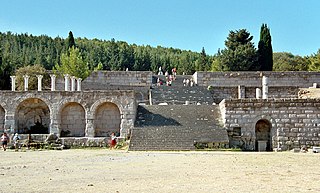
Asclepeions were healing temples located in ancient Greece, dedicated to Asclepius, the first doctor-demigod in Greek mythology. Asclepius was said to have been such a skilled doctor that he could even raise people from the dead. So stemming from the myth of his great healing powers, pilgrims would flock to temples built in his honor in order to seek spiritual and physical healing.

In ancient Greek religion, Telesphorus was a minor child-god of healing. He was a possible son of Asclepius and frequently accompanied his sister Hygieia. He was depicted as a dwarf whose head was always covered with a cowl hood or cap.

Nodens is a Celtic deity associated with healing, the sea, hunting and dogs. He was worshipped in ancient Britain, most notably in a temple complex at Lydney Park in Gloucestershire, and possibly also in Gaul. He is equated with the Roman gods Mars, Neptune and Silvanus, and his name is cognate with that of the Irish mythological figure Nuada and the Welsh Nudd.
Oneiromancy is a form of divination based upon dreams, and also uses dreams to predict the future. Oneirogen drugs may also be used to produce or enhance dream-like states of consciousness. It is dismissed by the scientific community and skeptics as being superstition; experiments do not support the idea that dreams predict the future beyond the expectations of the person dreaming. Occasionally, the dreamer feels as if they are transported to another time or place, and this is offered as evidence they are in fact providing divine information upon their return.
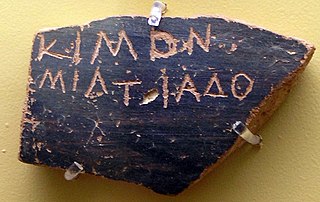
An ostracon is a piece of pottery, usually broken off from a vase or other earthenware vessel. In an archaeological or epigraphical context, ostraca refer to sherds or even small pieces of stone that have writing scratched into them. Usually these are considered to have been broken off before the writing was added; ancient people used the cheap, plentiful and durable broken pieces of pottery around them as convenient places to place writing for a wide variety of purposes, mostly very short inscriptions, but in some cases very long.

The Famine Stela is an inscription written in Egyptian hieroglyphs located on Sehel Island in the Nile near Aswan in Egypt, which tells of a seven-year period of drought and famine during the reign of pharaoh Djoser of the Third Dynasty. It is thought that the stele was inscribed during the Ptolemaic Kingdom, which ruled from 332 to 31 BC.

Lydney Park is a 17th-century country estate surrounding Lydney House, located at Lydney in the Forest of Dean district in Gloucestershire, England. It is known for its gardens and Roman temple complex.
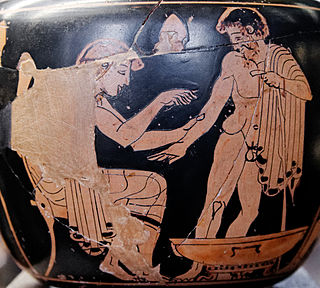
Ancient Greek medicine was a compilation of theories and practices that were constantly expanding through new ideologies and trials. Many components were considered in ancient Greek medicine, intertwining the spiritual with the physical. Specifically, the ancient Greeks believed health was affected by the humors, geographic location, social class, diet, trauma, beliefs, and mindset. Early on the ancient Greeks believed that illnesses were "divine punishments" and that healing was a "gift from the Gods". As trials continued wherein theories were tested against symptoms and results, the pure spiritual beliefs regarding "punishments" and "gifts" were replaced with a foundation based in the physical, i.e., cause and effect.

The concept of Hellenistic religion as the late form of Ancient Greek religion covers any of the various systems of beliefs and practices of the people who lived under the influence of ancient Greek culture during the Hellenistic period and the Roman Empire. There was much continuity in Hellenistic religion: people continued to worship the Greek gods and to practise the same rites as in Classical Greece.

A bimaristan, also known as dar al-shifa or simply maristan, is a hospital in the historic Islamic world.
Medicine in ancient Rome combined various techniques using different tools, methodology, and ingredients. Ancient Roman medicine was highly influenced by Greek medicine but would ultimately have its own contribution to the history of medicine through past knowledge of the Hippocratic Corpus combined with use of the treatment of diet, regimen, along with surgical procedures. This was most notably seen through the works of two of the prominent Greek Physicians, including Dioscorides and Galen, who practiced medicine and recorded their discoveries in the Roman Empire. This is contrary to two other physicians like Soranus of Ephesus and Asclepiades of Bithynia who practiced medicine both in outside territories and in ancient Roman territory, subsequently. Dioscorides was a Roman army physician, Soranus was a representative for the Methodic school of medicine, Galen performed public demonstrations, and Asclepiades was a leading Roman physician. These four physicians all had knowledge of medicine, ailments, and treatments that were healing, long lasting and influential to human history.
Age regression in therapy is a psycho-therapeutic process that facilitates access to childhood memories, thoughts and feelings. Age regression can be induced by hypnotherapy, a process where patients move their focus to memories of an earlier stage of life in order to explore these memories or to access difficult aspects of their personality.

Egyptian medical papyri are ancient Egyptian texts written on papyrus which permit a glimpse at medical procedures and practices in ancient Egypt. The papyri give details on disease, diagnosis, and remedies of disease, which include herbal remedies, surgery, and magical spells. It is thought there were more medical papyri, but many have been lost due to grave robbing. The largest study of the medical papyri to date has been undertaken by Humboldt University of Berlin and was titled Medizin der alten Ägypter.

Tutu was an Egyptian god worshipped by ordinary people all over Egypt during the Late Period. The only known temple dedicated to Tutu is located in ancient Kellis. However, reliefs depicting Tutu are seen in other temples, such as the Temple of Kalabsha. Tutu's title at the Shenhur temple was "Who comes to the one calling him". Other titles of his are "Son of Neith," "the Lion," "Great of Strength", and "Master of the demons of Sekhmet and the wandering demons of Bastet".

Trance is a state of semi-consciousness in which a person is not self-aware and is either altogether unresponsive to external stimuli or is selectively responsive in following the directions of the person who has induced the trance. Trance states may occur involuntarily and unbidden.
Renpetneferet is a minor goddess who is credited as being either the sister or the wife of Imhotep in Late Period Egyptian texts. There is no evidence of an individual by this name existing during the reign of King Djoser, although similar names were being used for women during the fourth dynasty.















